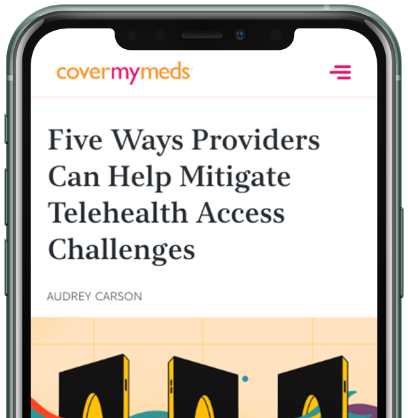Patient Support Programs: Bridging the Awareness Gap
Many patients still struggle to access programs designed to help them afford and manage their medications. To get more people the support they need, we must take a smarter approach, combining technology with a human touch.

It’s no secret that when high medication costs catch patients off-guard, tough choices often follow. Some cut doses, skip refills, and far too many abandon their treatment altogether. In 2023, nearly a quarter (24%) of patients walked away from the pharmacy empty-handed after learning their prescription cost more than anticipated.CoverMyMeds patient survey, 2023.
This isn’t a new challenge; as an industry, we’ve been working to solve it for years. One critical piece of the puzzle — detailed in our 2025 Medication Access Report — is patient support programs (PSPs): resources provided by pharmaceutical companies to help patients access, afford and adhere to medications. When patients connect with them, these programs can be life changing.
Yet too many patients are unaware of available PSPs, or often struggle to figure out how to access them. In order for these programs to fulfill their purpose, we, as an industry, have to help bridge that gap.
The Struggle to Reach Those in Need
The challenge that patient support programs (PSPs) face isn’t funding. Each year, pharmaceutical companies invest roughly $5 billion to help patients access their medications — but only 3% of patients utilize these programs.Sohn, Adam, et al. Making Patient Support EESI (EASY) Enhance, Empower, Simplify, Improve. IQVIA, 12 July 2023.
So, why the low engagement? To start, many patients aren’t aware PSPs exist: 59% have little to no knowledge of these resources.Bulik, Beth Snyder. Pharmas Return on $5B Spent Yearly on Patient Support Programs? Only 3% Are Using Them: Survey. Fierce Pharma, 6 July 2021. That’s a discouraging figure — but one that’s not entirely surprising since awareness gaps exist across the healthcare system: 42% of prescribers, for example, aren’t yet familiar with these programs either.Bulik, Beth Snyder. Pharmas Return on $5B Spent Yearly on Patient Support Programs? Only 3% Are Using Them: Survey. Fierce Pharma, 6 July 2021. This presents an opportunity: If more prescribers are informed, they can play an even greater role in helping patients access the support they need.Bulik, Beth Snyder. Pharmas Return on $5B Spent Yearly on Patient Support Programs? Only 3% Are Using Them: Survey. Fierce Pharma, 6 July 2021.
It’s clear that just creating these programs isn’t enough. Even the best PSPs won’t make an impact if patients are unaware of them or struggle to enroll.
Bringing Patient Support Programs to More People
For patient support programs to make a bigger impact, we must prioritize awareness and engagement. Information about PSPs needs to reach patients where they are, on their terms, through the channels they trust, and in ways that fit into their healthcare journeys.
In short, PSPs need to be better integrated. Pharmaceutical companies, providers, pharmacies, insurers and technology platforms all have a role to play in tying these programs into the patient journey. A successful strategy requires two key ingredients:
- Technology that empowers patients and providers with accessible solutions
- Human support that adds expert guidance and a personal touch to navigate challenges
Let’s take a closer look at what this would look like in practice.
Bridging Gaps with Better Technology
Both patients and prescribers expect healthcare to be as seamless and user-friendly as the digital tools they use daily. Across all age groups, the demand for intuitive, tech-driven healthcare solutions is growing — and the numbers prove it.
Take appointment scheduling, for example. Many patients don’t want to call a doctor’s office anymore: 92% of patients want the ability to schedule appointments online, and more than one-third of all patients — and nearly two-thirds of Gen Z — would switch providers for easier online scheduling.2024 Care Access Benchmark Report for Health Plans: Digital Access Insights from a Survey of 1,000 Healthcare Consumers. Kyruus Health, Kyruus, Inc., 2024.
The same goes for how patients want to communicate. Eight in 10 prefer digital communication with healthcare providers and brands.80% of Patients Prefer to Use Digital Communication to Interact With Healthcare Providers and Brands. Business Wire. Yet, despite these shifts, PSPs are still playing catch-up. While 44% of patients want to learn about PSPs online, only 10% do.Bulik, Beth Snyder. Pharmas Return on $5B Spent Yearly on Patient Support Programs? Only 3% Are Using Them: Survey. Fierce Pharma, 6 July 2021.
If we want PSPs to meet modern patient expectations, they must be easy to discover. They also need to offer:
- User-friendly platforms that make enrollment and navigation easy.
- Secure messaging for direct, HIPAA-compliant communication.
- Telehealth integration for better remote accessibility and engagement.
- Mobile-friendly solutions that let patients access services on the go.
- Interoperability across healthcare systems.
Technology has the potential to broaden the reach of PSPs dramatically. But as our latest Medication Access Report shows, investing in technology alone isn’t enough. The human element and expertise remain essential.
Strengthening the Human Touch
Patients want the convenience of digital tools but don’t necessarily want to trade personalized care for automation. Many still rely on the emotional and social support of human guidance, especially when critical information isn’t easy to find online.
When patients need answers, they often turn to real people. One study found that 42% of patients turned to their healthcare providers for guidance, while 32% reached out to customer service teams.80% of Patients Prefer to Use Digital Communication to Interact With Healthcare Providers and Brands. Business Wire. When it comes to patient support programs, many would prefer to hear about them from their pharmacists. But while 32% of patients want this interaction, only 14% receive it.Bulik, Beth Snyder. Pharmas Return on $5B Spent Yearly on Patient Support Programs? Only 3% Are Using Them: Survey. Fierce Pharma, 6 July 2021.
To be effective, PSPs must enhance the human connection. Field Reimbursement Managers (FRMs) are a great example of how real people can help bridge the gap between patients, providers and pharmaceutical companies.
FRMs help navigate insurance landscapes, reimbursement policies and prior authorization processes to assist doctors in helping those patients who qualify for assistance programs receive that support. They also serve as educators and hands-on problem solvers for provider offices, stepping in when technology alone isn’t enough to guide care teams through the process.
Building Smarter, More Effective Patient Support Programs
Success with patient support programs requires a shift in thinking. Instead of tweaking individual pieces, we must build a collaborative approach across the healthcare system.
This means breaking down silos. Beyond user-friendly platforms with mobile access and automated reminders, patients also need secure messaging that connects them to informed experts. Patients need reliable access to telehealth, but that technology should also be tied to human support. And patients must be able to hear about the programs through all channels — online, in pharmacies or through their providers.
When PSPs are easy to access and integrated into care, they can truly become a lifeline for patients. With a continuous flow of dynamic improvements, these programs can keep evolving to meet patient needs.
Of course, PSPs are just one part of a much bigger picture. The 2025 Medication Access Report takes a deeper dive into key data, trends and strategies that can help all healthcare stakeholders navigate the most common medication access challenges patients face. Get the full report for big-picture insights into the broader future of medication access.
The latest healthcare insights, floated right to your inbox.





